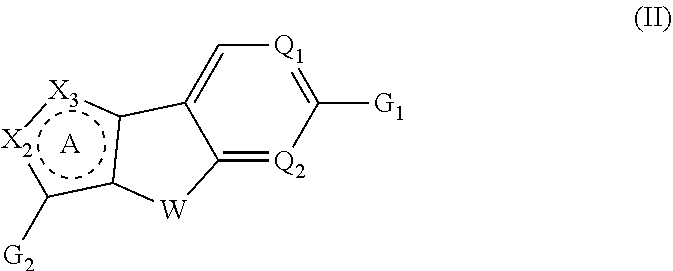Tricyclic heterocyclic compounds
a technology of heterocyclic compounds and tricyclic compounds, applied in the field of tricyclic heterocyclic compounds, can solve the problems of inability to fully absorb inability to bind to the lipids of the body,
- Summary
- Abstract
- Description
- Claims
- Application Information
AI Technical Summary
Benefits of technology
Problems solved by technology
Method used
Image
Examples
example 1
[0463]To a mixture of 5,5-dimethyl-3-(3-phenyl-4-(trifluoromethyl)isoxazol-5-yl)-4,5-dihydronaphtho[1,2-c]isoxazole-7-carbaldehyde (Preparation 1E, 0.034 g, 0.078 mmol) and azetidine-3-carboxylic acid (9.41 mg, 0.093 mmol) in methanol (0.5 mL) and dichloroethane (0.5 mL) at room temperature was added 3 drops of acetic acid via a Pasteur pipette. The reaction mixture was heated at 60° C. for 1 h. The reaction mixture was cooled to room temperature, sodium cyanoborohydride (5.94 mg, 0.093 mmol) was added, and the mixture was stirred at room temperature for 30 min. The reaction mixture was diluted with dichloromethane, washed with water, washed with brine, and dried over anhydrous sodium sulfate. Concentration under reduced pressure afforded the product (40 mg) as a dark tan solid. The solid was triturated with methanol with sonication and filtered under reduced pressure to give a dark gray solid (13 mg). By HPLC, the solid appeared to be the product.
[0464]The filtrate was concentrated...
examples 2 and 3
[0484]To a mixture of 3-(4-propylphenyl)-4H-chromeno[4,3-c]isoxazole-7-carbaldehyde and 3-(4-propylphenyl)-4H-chromeno[3,4-d]isoxazole-7-carbaldehyde (Preparation 2G, 0.023 g, 0.072 mmol) and azetidine-3-carboxylic acid (8.74 mg, 0.086 mmol) in methanol (0.5 mL) and dichloroethane (1.0 mL) at room temperature was added 3 drops of acetic acid via a Pasteur pipette. The heterogeneous reaction mixture was heated at 60° C. for 1 h. The reaction was cooled to room temperature, sodium cyanoborohydride (5.52 mg, 0.086 mmol) was added, and the mixture was stirred at room temperature for 4 h. The reaction mixture was diluted with dichloromethane, washed with water, brine, and dried over anhydrous sodium sulfate. Concentration under reduced pressure afforded a pale yellow solid (˜22 mg) which was triturated with methanol with sonication and filtered. The resulting pale yellow solid (7.5 mg) was purified by preparative HPLC to give an unspecified 3:2 mixture (1H NMR) of 1-((3-(4-propylphenyl)-...
example 4
[0500]To a solution of 3-(5-(1-methylcyclopropyl)-4-(trifluoromethyl)isoxazol-3-yl)-4,5-dihydronaphtho[1,2-c]isoxazole-7-carbaldehyde (Preparation 4G, 0.044 g, 0.113 mmol) in methanol (2 mL) and 1,2-dichloroethane (2 mL) was added azetidine-3-carboxylic acid (0.014 g, 0.136 mmol) followed by 5 drops of acetic acid. The reaction mixture was heated at 60° C. for 1.5 h. The reaction mixture was cooled to room temperature, and sodium cyanoborohydride (0.009 g, 0.143 mmol) was added. The reaction mixture was stirred at room temperature for 15 min. and then concentrated under reduced pressure. The crude residue was partitioned between dichloromethane and water, and the dichloromethane extract was concentrated and purified by silica gel chromatography using a 10% mixture of methanol in dichloromethane followed a 20% mixture of methanol in dichloromethane with 1% ammonium hydroxide to give the product (0.011 g). The compound was triturated with methanol and filtered to give 1-((3-(5-(1-meth...
PUM
 Login to View More
Login to View More Abstract
Description
Claims
Application Information
 Login to View More
Login to View More - R&D
- Intellectual Property
- Life Sciences
- Materials
- Tech Scout
- Unparalleled Data Quality
- Higher Quality Content
- 60% Fewer Hallucinations
Browse by: Latest US Patents, China's latest patents, Technical Efficacy Thesaurus, Application Domain, Technology Topic, Popular Technical Reports.
© 2025 PatSnap. All rights reserved.Legal|Privacy policy|Modern Slavery Act Transparency Statement|Sitemap|About US| Contact US: help@patsnap.com



